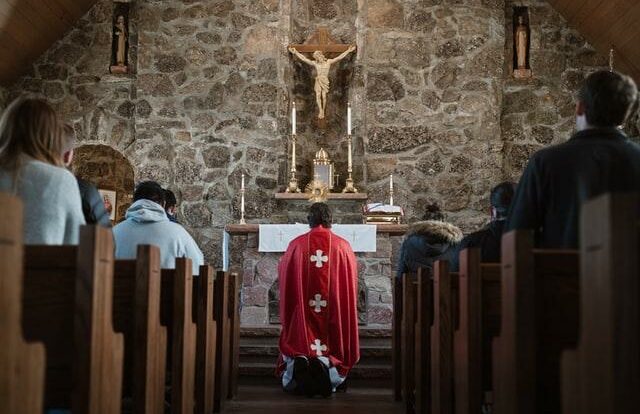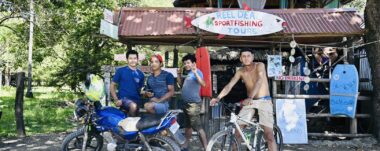Holy Week Celebrations: One of the Strongest Traditions in Costa Rica

The set of religious celebrations that commemorate the different stages of the Passion of Christ.
Every year, between the months of March and April, Holy Week is celebrated. A series of religious commemorative dates with a changing date since it is celebrated according to the Hebrew calendar, since the Last Supper or Holy Thursday coincided with the celebration of Pesach in Judaism. According to National Geographic, in the beginning it was called “The Great Week” but as it evolved it changed to what is now commonly know as Holy Week, a name associated with Palm Sunday and Easter Sunday, its beginning and end. The Catholic Church conmemorates the entrance of Jesus into Jerusalem once a year, welcoming him with palms and olive branches. The procession, the masses, the blessing of the palms and the religious movie classics that are broadcasted on national channels, such as “The Passion of Christ” are the main ceremonies that mark the beginning of this tradition in Costa Rica.
Article 75 of the Costa Rican Constitution establishes Costa Rica as a Catholic country, making it the only one in the American continent with an official religion. Because of this, celebrations such as Holy Week maintain a great importance at a national level with events organized by the church in each locality. Civil servants and students have entire week off, while Holy Thursday and Good Friday are mandatory holidays for all workers. With reduced responsibilities, the population takes the opportunity to participate in the religious festivities of their communities or make a massive exodus to the beaches.
Customs and Traditions.
The entrance of Jesus into Jerusalem is commemorated on Palm Sunday beginning with songs such as Hossana, which has with a profound meaning of salvation and the blessing of palms, which goes hand in hand with these allegorical songs. At the end of the Palm Sunday mass there is a procession in which the palms are blessed, which, once the mass is over, are not discarded. They are kept and taken to the church so that they can be burned and their ashes are used to mark the beginning of Lent the following year on Ash Wednesday.
The pastoral activities, carried out with the objective of taking care and spiritual advice to fulfill a certain objective, begin on Holy Monday with the Via Matris, a station of the path of faith and pain in which the Virgin walked from the Holy Sepulcher to her home. On Tuesday, they continue with the famous Via Crucis, the crucifixion of Jesus. It is a dramatization where the apostles, the Romans, among other characters begin to come to life thanks to the people who recreate them. The path is marked by 14 stations, which take us from the capture to the torment, the burial and later the resurrection. Each passage is there with the purpose of meditating, reading a gospel and finding some teaching that expresses that there is always a way through all kinds of difficulties that arise in life. On Wednesday, there is the Procession of the Arrest where people go to capture Jesus to continue the next day with the Chrism Mass. In this mass the bishop is a must along with the Chrism, one of the holy oils used in the Catholic Church. The Procession of the Meeting of the Virgin Mary and the Resurrected Christ, the Celebration of the Passion of the Lord and the Procession of the Holy Burial, are activities of Good Friday. On Saturday, the silence begins to prepare for the Easter Vigil, which consists of three important parts: Celebration of the New Fire, Liturgy of the Word and Baptismal Liturgy. All this to finally arrive at Easter Sunday.
On the other hand, the Lagarteada is a tradition that used to be practiced in the community of Ortega in Santa Cruz, Guanacaste and consisted in capturing the largest crocodile to exhibit it on Good Friday. This tradition is now totally prohibited. In its place, the Crocodile Festival is held. Allan Barboza, from La Voz de Guanacaste expressed the wish that:
“Through the festival, `the tradition could keep alive the importance of the crocodile for the culture of the people of Ortega, that an important economic income could be generated for the community, especially for women, through the sale of traditional foods (tanelas, rosquillas, tortillas, cuajadas…) and handicrafts. There was talk of marimba music and photo projection, crocodile watching tours in the river and the projection of a film in the community hall, all with support from the Sacred Crocodile Project and SINAC.” (2018)
This is, then, an alternative that tries to preserve the culture but without harming any animal or ecosystem.
On the other hand, Costa Rica is filled with the unique smells of traditional cuisine of this time of the year. Due to the meat ban, fish consumption increases, including sardines in spicy tomato sauce as a favorite, and alternative recipes, such as cod soup. The heat of those days is used to prepare homemade bread or other types of pastries, such as chiverre honey empanadas, bizcochos and tamal asado. The more rural areas are filled with a variety of picadillos made from ingredients such as palm heart, papaya and itabo flower, the latter famous for blooming specifically in the months of March and April.
Forgotten customs.
In the last century, there was an almost total paralysis of the country during Holy Week. One of the curiosities was the strict application of the Dray or Prohibition Law on these days, which forbids the sale of alcohol. Currently, Article 26 of the Liquor Law grants the municipal councils the power to regulate the sale and consumption of liquor on days of celebration of civic or cantonal events. Although the number of cantons that apply this measure during Holy Week has been in decline, there are still those that apply it, prohibiting the purchase and sale of alcoholic beverages during these dates. Despite five cantons implementing it in 2021, by 2022, only Alajuelita will apply the Dry Law.
The origin of this prohibition goes back to religious beliefs. While it is thought that one should not swim on Maundy Thursday or Good Friday for fear of drowning, there was also the belief that the true faithful do not drink alcohol during mourning. Since Easter commemorates the death of Jesus, the sale and consumption of liquor belittles his sacrifice.
Since a large part of the population is on vacation and it is dry season in Costa Rica, the beaches become the destination of choice. It is common for the roads to the coasts to be saturated with vehicles, especially on Holy Thursday and Easter Sunday. During Holy Week the sun is in a zenithal position creating hotter and drier conditions. This weather is a plus for filling beach hotels, the sea and swimming pools, but it is also key for successful processions, without the risk of being ruined by rain.
In 2020 and 2021 churches were affected by the suspension of all events in the wake of the COVID-19 pandemic. Some communities resorted to inventiveness, with clergy conducting a car ride with loudspeakers throughout the community, carrying religious images in the back of pick-up trucks, and depositing a palm leaf at the gate of each house. Masses were broadcast virtually, making it difficult for the community to share. Fortunately, this 2022 the return of processions was approved and Holy Week slowly returns to normal.
In Synthesis:
Holy Week is celebrated nationwide in Costa Rica, it alters activities, meals and schedules.
Typical activities of Holy Week are the blessing of the palms, the via crucis processions and the Festival del Lagarto (Crocodile Festival).
To date, the Prohibition Law is almost not enforced and vacation visits to beaches are very common.
Bibliography.
https://www.mtss.go.cr/prensa/comunicados/2021/marzo/cp_08_2021.html
http://www.pgrweb.go.cr/scij/Busqueda/Normativa/Normas/nrm_texto_completo.aspx?nValor1=1&nValor2=73058
https://www.crhoy.com/nacionales/por-que-hace-tanto-calor-en-semana-santa
Authors:
Angie Loveday and Zelda Walters
for Sensorial Sunsets
www.sensorialsunsets.com
Navigate articles





